What Comes to Mind When You Think of Yoga?
Do you picture a calm yogi sitting peacefully on a cushion, deep in meditation? Or maybe you imagine someone sweating through a series of strong, breath-synced poses? If your idea of yoga leans toward the powerful and athletic side, then Power Yoga might be exactly what you’re looking for. Even a 20-minute beginner Power Yoga routine can be a fantastic way to boost your overall health and wellness.
What Is Power Yoga?
Power Yoga stems from Ashtanga Yoga and is known for its dynamic, physically demanding flows. It’s a movement-based practice where you sync your breath with each posture. Expect core work, balance challenges, and poses that build strength and stability. After a class, you’ll feel sweaty, energized, and strong.
It’s a relatively modern style that started in the West, blending traditional Indian yoga with the intensity of fitness training. Power Yoga has gained popularity nationwide thanks to its invigorating, workout-like feel. It helps build muscle, boost stamina, and tone the body—all while offering emotional and energetic benefits. Many people practice Power Yoga to lose weight, improve core strength, and simply feel good.
Can Anyone Do Power Yoga?
Absolutely! Even though it’s a tough practice, Power Yoga is suitable for all levels. If you’re just getting started, don’t worry—there are always modifications you can take. Over time, you’ll naturally build up your strength, flexibility, and endurance.
It’s best to ease into it. Try starting with a class once or twice a week, or do a 20-minute beginner session at home every few days to get used to the flow and intensity.
Is Power Yoga a Good Workout?
Definitely. Power Yoga isn’t just great for your body—it’s also amazing for your mind. You’ll still get the usual yoga perks like mindfulness, stress relief, and inner calm, but the physical benefits are on another level.
While you’ll see familiar yoga poses, they’re performed faster than in slower-paced classes like Hatha Yoga. Flows are typically linked through vinyasas, and sometimes you’ll hold poses to really build muscle and improve balance. It’s a dynamic, full-body workout that’s both grounding and energizing.
Benefits of Power Yoga
Power Yoga offers so much more than just physical strength. Even if you start with fitness in mind, you’ll likely notice mental and emotional shifts too. Some key benefits include:
- Builds strength & stability: Repeating vinyasa flows helps you get stronger from the inside out.
- Boosts stamina: The fast pace pushes your endurance and prepares you for other physical activities.
- Burns calories: Many turn to Power Yoga for weight management or fat loss.
- Tones your body: The movement sculpts longer, leaner muscles.
- Strengthens your core: A solid core is key, and you’ll feel yours engage more over time.
- Relieves stress: The calm post-practice feeling sticks with you throughout the day.
- Improves balance & focus: Balancing postures help sharpen your concentration.
- Increases flexibility: Like all yoga, it stretches your muscles and opens up the body.
- Enhances body awareness: You’ll naturally become more in tune with your body and breath.
- Promotes mindfulness: You’ll learn to stay present and aware of your thoughts and emotions.
20-Minute Beginner Power Yoga Routine
You don’t need anything fancy—just a mat, your body, and maybe a block. You can practice at home, while traveling, or even on a lunch break. Modify poses as needed, and always listen to what your body tells you.
The key is to take it slow at first. Syncing breath and movement might feel tricky, but consistency will help you build strength, stamina, and flexibility. Stay connected to your breath, engage your core, and enjoy the process.
Warm-Up
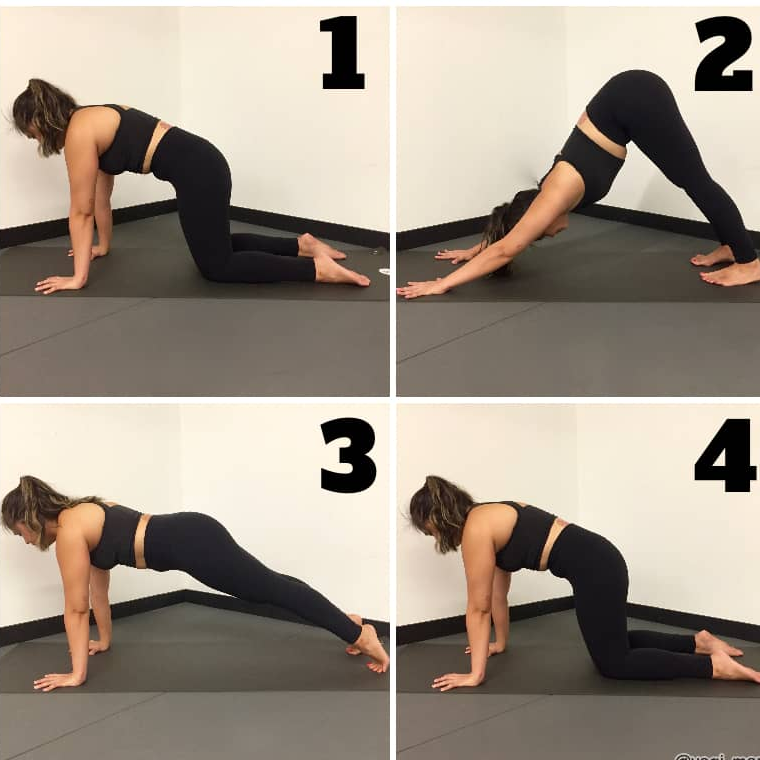
Let’s get started with a gentle warm-up to link breath and movement:
- Start in tabletop: On hands and knees, wrists under shoulders, knees under hips.
- Inhale – Cow Pose: Arch your back, lift your gaze, tailbone up.
- Exhale – Downward Dog: Lift your knees and hips, push into your hands.
- Inhale – Plank Pose: Shift forward, body in one line.
- Exhale – Tabletop: Return to hands and knees.
Repeat this flow 5 times, then return to Downward Dog.
First Flow
This flow will get your body warm and core activated:
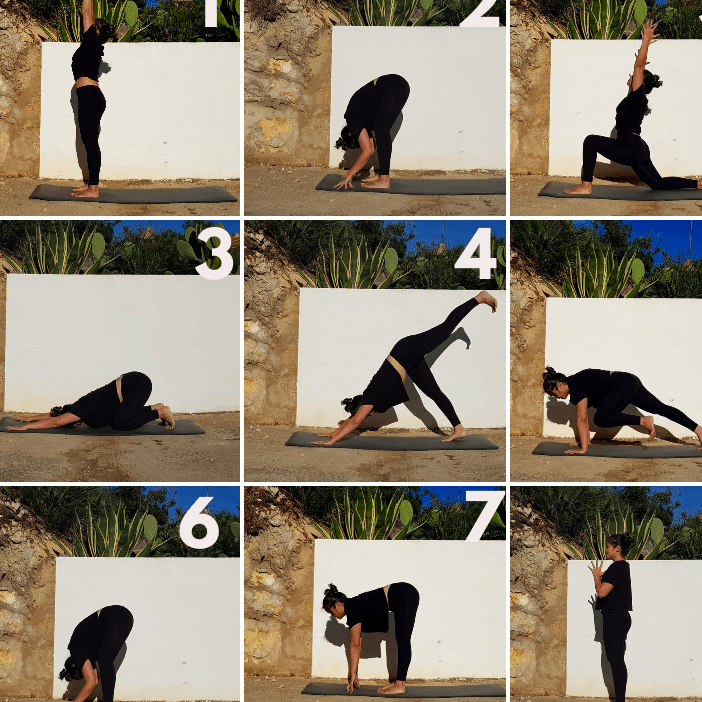
- From Downward Dog, step to the top of your mat.
- Inhale – Stand tall, hands to heart.
- Inhale – Reach arms up.
- Exhale – Forward fold.
- Inhale – Step right foot back, low lunge.
- Exhale – Left foot back, Downward Dog.
- Inhale – Plank Pose.
- Exhale – Modified Child’s Pose (toes curled under, arms extended).
- Inhale – Return to Plank.
- Exhale – Downward Dog.
- Inhale – Lift right leg, Down Dog Split.
- Exhale – Right knee to right elbow.
- Inhale – Lift leg again.
- Exhale – Knee to left elbow.
- Inhale – Lift leg again.
- Exhale – Knee to nose.
- Step foot forward, then step left foot forward, fold.
- Inhale – Halfway lift. Exhale – Fold.
- Inhale – Rise to stand. Exhale – Mountain Pose.
Repeat the sequence on the left side.
Second Flow – Warrior Series
Repeat this sequence twice. First time: hold each Warrior pose for 3–5 breaths. Second time: move with each breath.
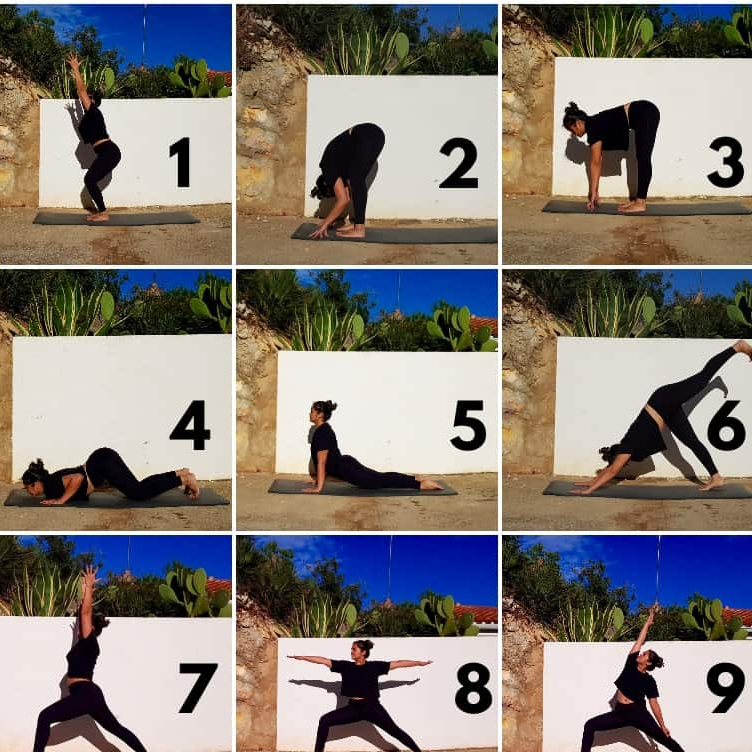
- Chair Pose – Bend knees, arms up.
- Exhale – Fold forward.
- Inhale – Halfway lift.
- Exhale – Step back to Plank.
- Exhale – Lower to Chaturanga or knees-chest-chin.
- Inhale – Cobra or Upward Dog.
- Exhale – Downward Dog.
- Inhale – Right leg up. Exhale – Knee to nose, step forward.
- Inhale – Warrior 1 (hips square, arms up).
- Straighten front leg, rotate into Warrior 2 on the back leg.
- Inhale – Flying Warrior (arms overhead, legs straight).
- Exhale – Warrior 2 on the other side.
- Peaceful Warrior – Reach up and back.
- Exhale – Low lunge, step back, and take a Vinyasa.
- Repeat on the left, then run through it again moving one breath per movement.
Standing Poses
Hold these for a few breaths to build balance and strength. Use a block if needed.
Triangle Pose
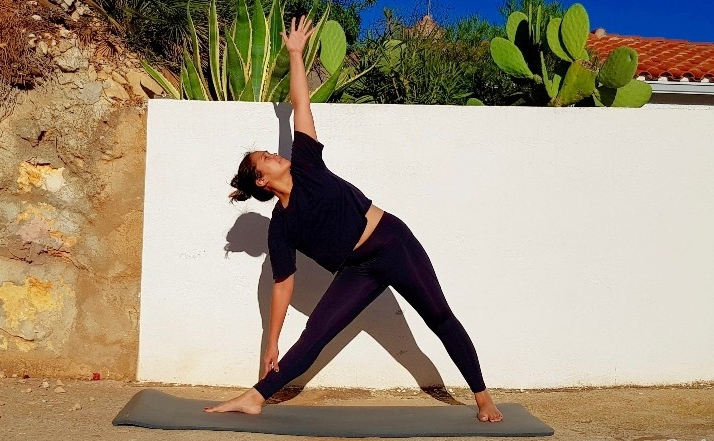
- Walk hands back to feet, slowly stand.
- Turn to face left, step wide.
- Turn right toes forward, arms out.
- Reach right hand down, left arm up.
- Hold for 5 breaths.
Half Moon Pose
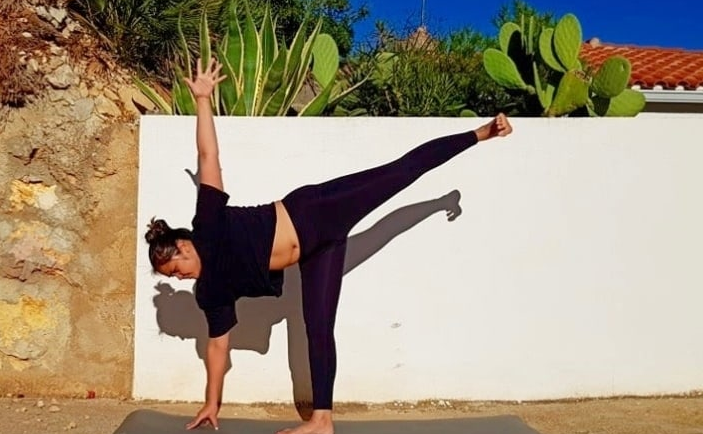
- Look down, bend right knee, shift weight forward.
- Lift left leg, flex toes, stack hips.
- Extend top arm or rest it on hip.
- Gaze up or down, hold 5 breaths.
- Step back to Warrior 2.
- Turn to face left, repeat on left side.
Core + Cool Down
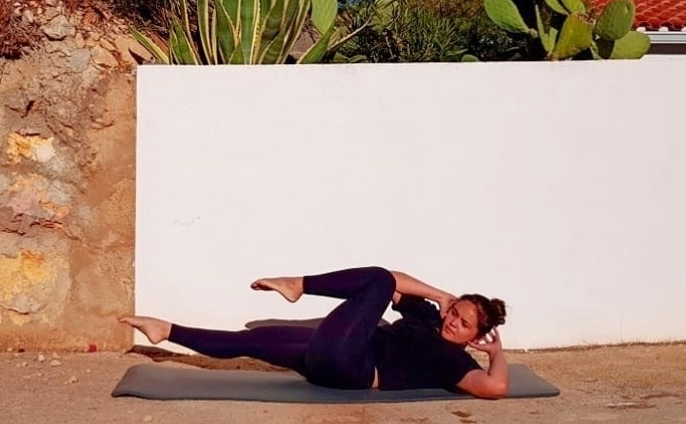
Let’s engage the core and wind down.
Yoga Bicycle
- Lie on back, knees lifted, shins parallel.
- Hands to ears, elbows wide.
- Inhale – Lift head and shoulders.
- Alternate elbows to knees, hover opposite leg 2” above floor.
- Repeat for 10 rounds.
Supta Baddha Konasana

- Hug knees in.
- Soles of feet together, knees wide.
- Arms by your side, breathe deeply for 5 breaths.
Savasana
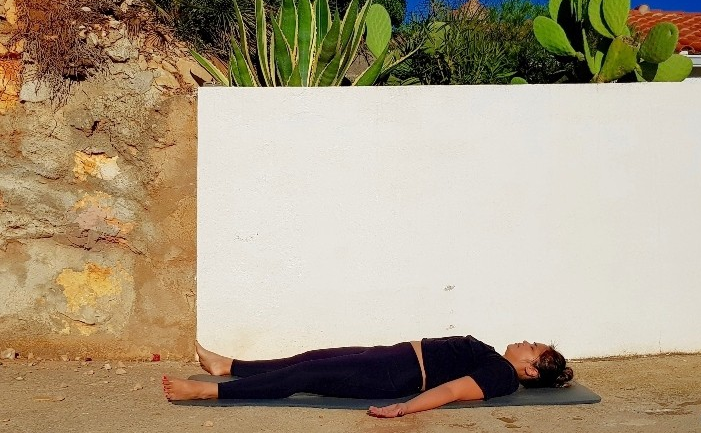
- Extend legs, arms at sides, palms up.
- Close eyes and relax for 2–3 minutes.
Final Thoughts
Power Yoga is challenging but incredibly rewarding. If you’re just starting out, be patient. Focus on your breath, listen to your body, and have fun with the process. With consistent practice, you’ll be flowing with confidence in no time!
Related Questions
What is Hot Power Yoga?
It’s the same dynamic style but done in a heated room. The heat helps your muscles open up more and increases intensity.
Can I practice Power Yoga daily?
Yes, you can—but always listen to your body. Some days may call for a gentler or restorative practice, and that’s perfectly okay.

Leave a Reply